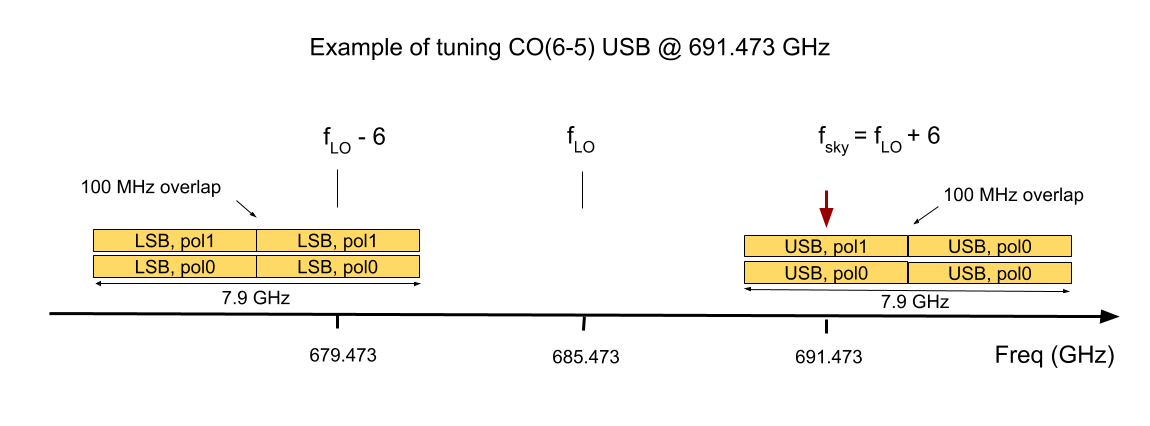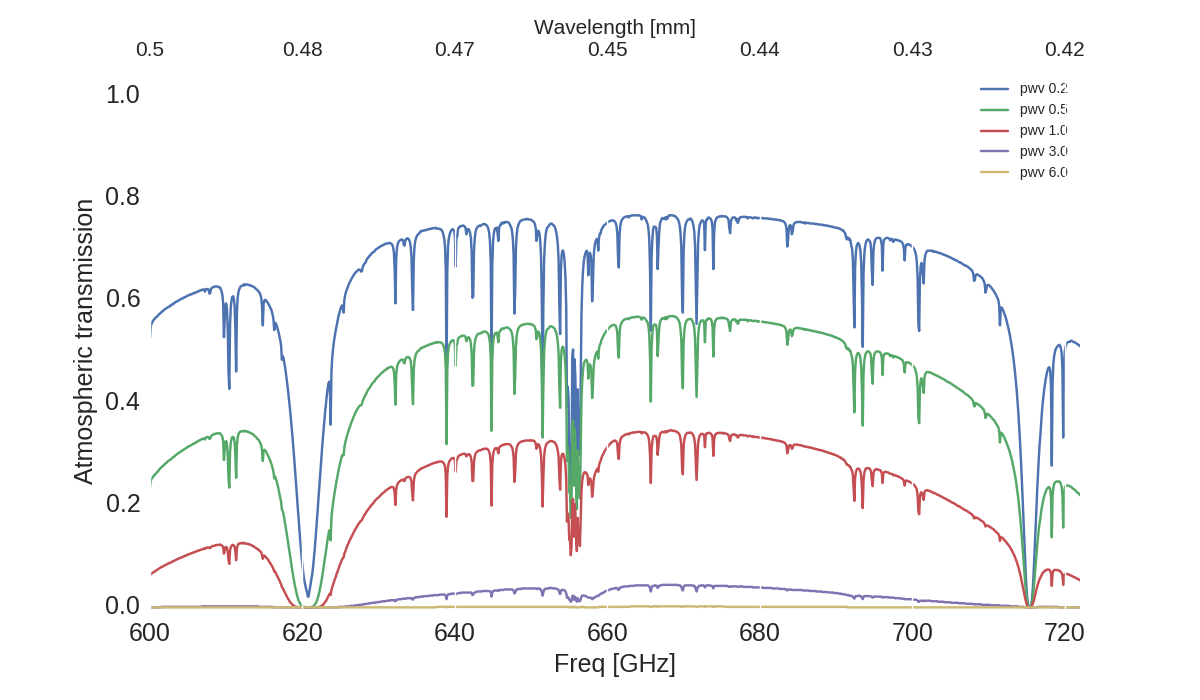Technical details
The SEPIA660 channel is a dual polarisation 2SB receiver delivered by the NOVA group. It was installed and commissioned during the second half of 2018. It replaced the previous DSB receiver built to the specifications of ALMA band 9, based on a pre-production ALMA Band 9 receiver cartridge.
The SEPIA660 receiver has two IF outputs per polarisation, USB and LSB, each covering 4-12 GHz, adding up a total of 32 GHz instantaneous IF bandwidth. The central frequencies of the two sidebands are separated by 16 GHz.

Each sideband (and polarisation) is recorded by two FFTS spectrometer units, each of them sampling 4 GHz, in the following configuration:
Therefore, both units overlap in the middle for about 100 MHz and the full coverage is slightly smaller than 8 GHz (7.9 GHz).
Line setups are designed to avoid placing the astronomical interesting line in the overlap region where aliasing effects are present. This is why the tuning sky frequency is placed in the middle part of one of the FFTS units, at 6 GHz from the LO frequency. In this configuration (shown in the figure above) the spectral coverage is not symmetric around the tuning frequency, and this needs to be considered when aiming for other transitions inside the band or when performing line surveys.
The sideband rejection ratio is by design >10 dB over the full band coverage.
The commissioning at the telescope of SEPIA660 was successfully done in Aug-Oct 2018. By that time, the instrument was occupying one of the PI positions inside the Nasmyth cabin (A-cabin). The noise temperature was measured to be < 335 K all over the band, with a reference value ~225 K @ 600 GHz. These noise values determined in the commissioning have been incorporated in the SEPIA660 observing time estimator. The sideband suppression was measured to be better than 20 dB and the stability (Allan times) were estimated to be between 5-10s (total power) and >100 s (spectroscopic) at different tuning frequencies. In January 2019 the cryostat was moved to the middle facility position (also in the A cabin) and some of the commissioning measurements were repeated, confirming similar results.
SEPIA660 Atmospheric window

In the figure above the atmospheric transmission in the SEPIA660 frequency range (600-720 GHz) is shown. At this atmospheric window you need submillimeter weather conditions to have atmospheric transmission higher than 50%.
Observing with SEPIA660
SEPIA660 is a Facility receiver so everybody is welcomed to use it, independently of the partner. Given the 2SB capability and the wide bandwidth coverage (7.9 GHz + 7.9 GHz), SEPIA660 is a very interesting instrument to perform line surveys at high frequency.
If you are interested only in particular transitions, think on a strategy to place the lines of your interest with the minimum number of tunings. Due to the number of atmospheric absorption within this band, it is essential that you check the Instrument setup tool to optimise your tunings.
Technical papers about SEPIA660.
Belitsky, V.; Lapkin, I.; Fredrixon, M.; Meledin, D.; Sundin, E.; Billade, B.; Ferm, S. -E.; Pavolotsky, A.; Rashid, H.; Strandberg, M.; Desmaris, V.; Ermakov, A.; Krause, S.; Olberg, M.; Aghdam, P.; Shafiee, S.; Bergman, P.; De Beck, E.; Olofsson, H.; Conway, J. De Breuck, C.; Immer, K.; Yagoubov, P.; Montenegro-Montes, F. M.; Torstensson, K.; Pérez-Beaupuits, J. -P.; Klein, T.; Boland, W.; Baryshev, A. M.; Hesper, R.; Barkhof, J.; Adema, J.; Bekema, M. E.; Koops, A. SEPIA – a new single pixel receiver at the APEX telescope Astronomy & Astrophysics, (2018) Volume 612, A23, (12 pages).
Baryshev, A. M.; Hesper, R.; Mena, F. P.; Klapwijk, T. M.; van Kempen, T. A.; Hogerheijde, M. R.; Jackson, B. D.; Adema, J.; Gerlofsma, G. J.; Bekema, M. E.; Barkhof, J.; de Haan-Stijkel, L. H. R.; van den Bemt, M.; Koops, A.; Keizer, K.; Pieters, C.; Koops van het Jagt, J.; Schaeffer, H. H. A.; Zijlstra, T.; Kroug, M.Lodewijk, C. F. J.; Wielinga, K.; Boland, W.; de Graauw, M. W. M.; van Dishoeck, E. F.; Jager, H.; Wild, W., The ALMA Band 9 receiver. Design, construction, characterisation and first light, Astronomy & Astrophysics, Vol 577, A129 (12 pages).